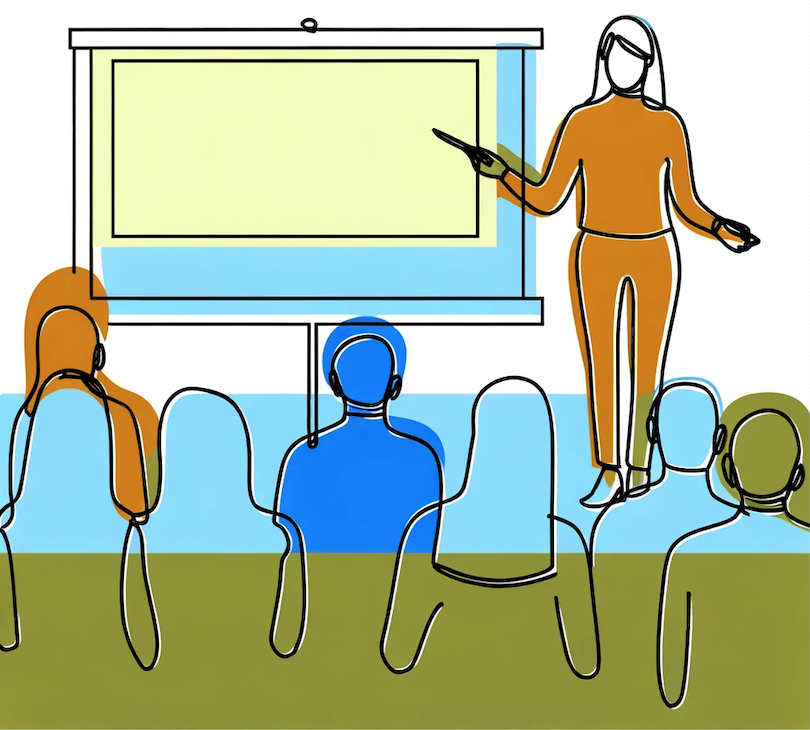What to Do About Assessment?
Suggested Assessment Types
We will discuss a just few assessment types in depth. There are countless suggestions for assessments online; we will link to some pages and repositories at the end of this section, but keep your eyes open locally and further afield for new collections.
Oral Exams
Oral exams, while common in undergraduate programs in Europe, are not extensively used in many disciplines other than languages in North America. Oral exams have a number of perceived drawbacks—in addition to actual drawbacks—all of which can be mitigated. They are an excellent solution for increasing the AI-immunity of an assessment, but more than that, they confer numerous increased learning—and teaching!— benefits.
Let’s start by defining what an oral exam actually is: essentially, an exam (of any length) where the instructor asks questions of a student, and the student replies orally and explains their thinking.
 There is a misconception that the purpose of oral exams is to “catch out” students in real time, and this facet of a synchronous oral exam is likely what strikes fear into most students’ hearts: the idea that, instead of sitting quietly with their exam paper, reading the questions and answering them in whichever order they chose, the student is subject to a barrage of questions from an unforgiving examiner. However, if both parties conceive of the exam as more of a conversation, the anxiety level can come down quickly. Furthermore, because oral exams can be tailored, in the moment, to the student’s abilities, the examiner can rephrase a question, give hints, or let a student know they’re going down the wrong path and guide them back to the appropriate topic. On a paper exam, a student who misunderstands or makes an error early on may end up getting a zero on the question; in an oral exam, the instructor can give hints to steer the student back on track, or probe as to why they are taking the approach they are. Students who are doing well and know the material may end up receiving more challenging questions and may feel unsettled at the fact that they’re not getting everything “right” on the first try. If the examiner carefully adheres to a rubric, the grading will be fair, and the advanced student may find themselves having a graduate-level discussion/oral exam, simply due to their own competencies (while presumably also scoring a very high grade).
There is a misconception that the purpose of oral exams is to “catch out” students in real time, and this facet of a synchronous oral exam is likely what strikes fear into most students’ hearts: the idea that, instead of sitting quietly with their exam paper, reading the questions and answering them in whichever order they chose, the student is subject to a barrage of questions from an unforgiving examiner. However, if both parties conceive of the exam as more of a conversation, the anxiety level can come down quickly. Furthermore, because oral exams can be tailored, in the moment, to the student’s abilities, the examiner can rephrase a question, give hints, or let a student know they’re going down the wrong path and guide them back to the appropriate topic. On a paper exam, a student who misunderstands or makes an error early on may end up getting a zero on the question; in an oral exam, the instructor can give hints to steer the student back on track, or probe as to why they are taking the approach they are. Students who are doing well and know the material may end up receiving more challenging questions and may feel unsettled at the fact that they’re not getting everything “right” on the first try. If the examiner carefully adheres to a rubric, the grading will be fair, and the advanced student may find themselves having a graduate-level discussion/oral exam, simply due to their own competencies (while presumably also scoring a very high grade).
Limitations of Oral Exams
So what are some of the drawbacks—perceived or otherwise— of oral exams from the instructor point of view?
The first is of the amount of time oral exams take; this is perception is often a deal-breaker for busy faculty members. However, a well-structured oral exam can take a similar amount of time as it takes to grade a written exam. And, because the oral exam substantially reduces the possibility of cheating, there is time saved on potential academic integrity procedures. If an instructor is able to quickly determine that the student in front of them doesn’t understand the material, they can assign a low grade and move on. Compare this to reading a take-home assessment where the instructor suspects an academic integrity violation. The first step in this procedure would likely be to meet with the student to discuss their work, and potentially quiz them to determine if they really did write the assignment, which may then be followed by an academic misconduct investigation. Instructors who have had to put together these cases know how time-consuming they can be (as well as hard on one’s psyche); what if the assessment structure obviated these steps by simply having that “conversation to discuss the student’s understanding” up-front, as an oral exam?
Another time-saver for oral exams is to have a robust rubric or checklist that the instructor fills out during the exam, on which the grade is based. This means that the grading time is reduced to the examination time. Some instructors choose to focus exclusively on the questioning part during the exam, recording (audio or video) the exams to grade later. While recording exams may be a necessary step in fulfilling institutional requirements of preserving assessments in the case of student appeal of a grade, it is not necessary for the instructor to review the entire exam if they want a refresher on a part of the student’s exam. Instructors could either listen to a short piece of the exam or use transcribing software to produce a written version of the students’ responses that could be easily cross-referenced (any questionable pieces in an auto-transcribed text could be verified by listening to a small part of the recording ).

Another potential drawback to oral exams is the need for accommodations for accessibility. There are students who have difficulty expressing themselves orally, for whom the higher education status quo of primarily written exams works well. However, there are potentially just as many students with dyslexia, dysgraphia, or other visual-spatial learning disabilities for whom oral exams are a lifesaver. Much of the need for accessibility around oral exams is anecdotally due not to the inability to express oneself orally, but the anxiety around this different type of exam. This then falls into a different category of accommodation, that of performance anxiety or test anxiety, and there are different ways to address it. Framing the test as a supportive conversation where the examiner will help, rephrase, and guide the student through the questions can often relieve some of this anxiety. We discuss some strategies for reducing student anxiety below.
For students who truly cannot speak, there are other accommodations, including writing out answers to verbal questions and showing them to the examiner, or having a bespoke written examination.
One final drawback to oral exams is the organizational headache that comes along with scheduling, arranging, and administering them. In a perfect world, where the examiner has scheduled enough buffer time (but not too much!) and students are lined up outside the classroom door (or, completely ready with all systems functioning online), oral exams can run quite smoothly. However, if a student is late, if some technology falters, or if a student needs extra time during their exam because of anxiety or other emotions, this can affect the whole series. One of the significant benefits of a written exam is the ability to walk away with a stack of papers; once the exam is over, it is only the grader’s schedule that is affected. However, if the instructor fills out the rubric during the exam, then the grading is finished when the exam is finished. For instructors’ own self-preservation, we recommend scheduling half-day blocks of oral exams, and anticipating not getting much other work done during the exam period. However, this is likely not too dissimilar from the burdens of grading papers.
Those are the potential drawbacks (with mitigations). Are there any true benefits to oral exams, beyond the idea that students will be truly tested, without being able to use AI?
Benefits of Oral Exams
Luckily, there are many! If you were sitting on the fence about implementing oral exams, perhaps these could push you into trying it:
Authentic Assessments
 Not only will oral exams be preparing undergraduate students for comprehensive (oral) exams in graduate school, but learners will be practicing for situations in real life where they will be assessed on their ability to orally express knowledge. From presentations to a boss or client, to problem-solving in a group, to explaining why your library book is overdue, oral demonstration of knowledge is constant in modern life. And, with potentially more writing being done by LLM-based tools, the ability for an individual to write well will be less important. However, at least for now, being able to speak knowledgeably—and to think on the spot— will still be essential. Sayre describes the importance of oral communication among scientists as having two facets, “…. both rehearsed (as in a talk) and extemporaneous (as in the research group meeting or hallway)” (Sayre, 2014). Indeed, the invention of the transformer, foundational to all of today’s LLM chatbots, by a group of eight software engineers may well have been catalyzed by just such a hallway conversation (Murgia, 2023).
Not only will oral exams be preparing undergraduate students for comprehensive (oral) exams in graduate school, but learners will be practicing for situations in real life where they will be assessed on their ability to orally express knowledge. From presentations to a boss or client, to problem-solving in a group, to explaining why your library book is overdue, oral demonstration of knowledge is constant in modern life. And, with potentially more writing being done by LLM-based tools, the ability for an individual to write well will be less important. However, at least for now, being able to speak knowledgeably—and to think on the spot— will still be essential. Sayre describes the importance of oral communication among scientists as having two facets, “…. both rehearsed (as in a talk) and extemporaneous (as in the research group meeting or hallway)” (Sayre, 2014). Indeed, the invention of the transformer, foundational to all of today’s LLM chatbots, by a group of eight software engineers may well have been catalyzed by just such a hallway conversation (Murgia, 2023).
Better Testing I
Many STEM exams contain shorter, simpler problems than would be ideal (Chen, 2020), simply because, if a student makes a mistake in early steps in a paper-based exam, they will end up with an unfairly low grade. In an oral exam, early mistakes can be discussed and corrected, and examiners can keep the students on the right path to get to the higher-order thinking that they really want to test.
Better Testing II
Oral exams allow instructors to test students’ conditional knowledge (the ability to apply knowledge to a particular context, and to explain why) not just procedural knowledge (using equations), which is common in written tests (Delson et al., 2022). Students can also better elaborate their problem-solving strategy, not just dive into the problem-solving process, which improves meta-cognition.
Better Testing and Better Learning I
Oral exams become not only an assessment method, but also a learning approach in their own right, as students who explain their ideas out loud end up learning more about the topic, especially when the conversation is scaffolded by an expert (the examiner) (Boser, 2017).
Better Testing and Better Learning II
Students receive immediate, specific, personalized feedback on their performance and learning: “…there is strong evidence that students benefit a great deal from personalized feedback that is given in a tutorial setting where they have social and other incentives to absorb it, synthesize it, and deploy it anew” (Clay, 2023).
Better Learning I
One study found that oral exams increased engineering students’ motivation to learn, in addition to improving their grades on written exams administered after the oral exams (Delson et al., 2022).
Better Learning II
Mary Nelson’s study of at-risk Calculus students showed that students participating in voluntary oral assessments before written tests did significantly better on both grades in the course and on the common final exam than comparable students in the control group. Not only that, their retention was better: they passed Calculus I, then enrolled in and passed Calculus II at “dramatically higher rates than at-risk students in the control group” (p. 47, Nelson, 2010). Based on these results, oral exams were offered in all Calculus courses, even though the class size was often over 500 students.
More Interesting for the Examiner I
 How many times has an instructor been bored to tears grading papers on the same topics? Even when students are given a choice of topics, oftentimes they cluster around one subject. Oral exams allow examiners not only to adapt the level of questions to the individual, but also to examine different topics. As long as there is a robust rubric to ensure that the exam is covering the appropriate learning outcomes and that the questions are fair, oral exams can end up being more interesting than written ones.
How many times has an instructor been bored to tears grading papers on the same topics? Even when students are given a choice of topics, oftentimes they cluster around one subject. Oral exams allow examiners not only to adapt the level of questions to the individual, but also to examine different topics. As long as there is a robust rubric to ensure that the exam is covering the appropriate learning outcomes and that the questions are fair, oral exams can end up being more interesting than written ones.
More Interesting for the Examiner II
Contrasting to the work required to grade a student’s written assessment, Clay says “Per minute, I enjoy myself so much more [with the oral exams]. Writing extensive written feedback and sending it into the abyss — even if its absorption is incentivized by being linked to subsequent assignments — is painful in a special way that grinds on me, especially when I have to do a lot of it” (Clay, 2023).
Instructors Get to Meet Students
University of Waterloo Math professor Anton Mosunov notes that, while conducting 74 oral exams for 15 minutes each was time-consuming, it allowed him to have personal contact with his students, which is especially crucial in fully online courses. “I was able to break down the barrier with students who had never approached me with their questions before. Since the exam, those students are reaching out for help” (Chen, 2020).
Strategies for Oral Exams
One strategy that helps students prepare for an oral exam while simultaneously lessening their anxiety is for the first question to be talking through a problem from their homework or a previous assignment. In this way, the student has already solved—or at least worked on—the problem and starts off simply talking their way through what they did to solve it. The examiner can then ask questions to push that line of thinking, and/or embark on different topics. The student feels more confident knowing what the first question that will be asked is and gets warmed up by talking about a problem they’ve already mastered, as a way to ease into the exam.
Another strategy for reducing anxiety is to have the exam be open book. Even if students never need to consult their notes, they may feel more comfortable with their textbook close by. Encouraging students to create a “cheat sheet” of notes is a good way for them to review material, even if they never need it.
The most significant anxiety-reducing feature of an oral exam is the examiner’s attitude. Sayre describes her oral exams as a “friendly, guided conversation about physics” (Sayre, 2014). Maintaining a kind, supportive attitude throughout the exam will have the greatest positive effect on students. This can be challenging for the examiner, who must be “on” for all of the exams. Whereas a student may find it overwhelming to be quizzed for 20–30 minutes straight, consider the poor examiner who must ask questions, interpret answers, give hints, scaffold thoughts, push learners, while simultaneously grading them…..for each and every student!
 Setting the expectations for students is important. In the vein of maintaining a “friendly conversation,” Dan Styer writes about his oral physics exams, “Your examiner is testing your reasoning skills, not your appearance. Don’t dress in elegant ‘dress for success’ fashion. Wear comfortable clothing that will not fall off when you’re writing on the chalkboard” (Tips for Oral Exams).
Setting the expectations for students is important. In the vein of maintaining a “friendly conversation,” Dan Styer writes about his oral physics exams, “Your examiner is testing your reasoning skills, not your appearance. Don’t dress in elegant ‘dress for success’ fashion. Wear comfortable clothing that will not fall off when you’re writing on the chalkboard” (Tips for Oral Exams).
Media Attributions
- This image was created using DALL·E
- This image was created using DALL·E
- This image was created using DALL·E
- This image was created using DALL·E
- This image was created using DALL·E

